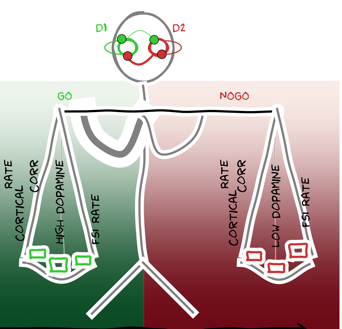To Go or Not to Go? Scientists explain how the striatum may help us decide which action to undertake
These two pathways originate as the output of two different types of neurons in the striatum, which express either D1 or D2 type dopamine receptors, respectively. Striatal neurons belonging to these two pathways mutually inhibit each other and the one cell type with the higher firing rate sets the stage for a Go or No-Go decision.
New experimental data have revealed that D2 neurons inhibit D1 neurons more strongly than the other way around. This means that the No-Go pathway is stronger and, therefore, a No-Go decision is the default state of the striatum. Thus, D1 neurons require a stronger input to overcome the No-Go pathway. Indeed, Go pathway neurons receive stronger excitation form the neocortex than No-Go pathway neurons do, which evens the competition.
In a new paper published in the journal PLoS Computational Biology, Jyotika Bahuguna, Ad Aertsen and Arvind Kumar from the Bernstein Center Freiburg show that the stronger inhibitory connectivity from D2 to D1 neurons makes the striatum function as a threshold device: weak neocortical inputs result in a higher activity in the Go pathway, whereas stronger inputs make the No-Go pathway overcome the Go pathway. The amount of cortical input activity at which the striatal preference shifts from Go to No-Go is referred to as the decision transition threshold (DTT).
While the DTT is determined primarily by the connectivity between the Go and No-Go pathway neurons, Bahuguna and colleagues demonstrate that a number of other components of the basal ganglia can modulate the DTT. Amongst those, the most prominent is the neuromodulator dopamine, which is crucial for a variety of motor and cognitive functions. A low dopamine level lowers the DTT and, hence, lowers the threshold at which the No-Go pathway can express the higher activity, needed to win the competition. A high dopamine level, by contrast, has the opposite effect. These observations provide putative mechanisms to understand the link between dopamine concentration and behavioral deficits in Parkinson’s disease patients, such as L-Dopa Induced dyskinesia, higher reaction times and DBS (deep-brain stimulation) induced impulsivity.
Earlier computational models have considered the striatum as a homogenous population of neurons, with the competing Go and No-Go neuron subpopulations being interchangeable. This would imply that the Go/No-Go decision would be made outside the striatum. The new description proposed here, of the striatum being a dynamic threshold device, emerging in a natural way from its internal connectivity structure, assigns a much more active role to the striatum in shaping Go/No-Go decisions than the more passive role attributed to it so far.
With their new model, Bahuguna and colleagues not only advance our conceptual understanding of striatal and basal ganglia function, but they also provide novel insights into brain disorders involving basal ganglia dysfunction. This may, hopefully, pave the way for better therapeutic interventions of such brain disorders.
Original publication:
Bahuguna J, Aertsen A, Kumar A (2015)
Existence and control of Go/No-Go decision transition threshold in the striatum
PLoS Comp Biol 11(4): e1004233.
doi:10.1371/journal. pcbi.1004233
Figure caption:
Decision Transition Threshold (DTT) in the striatum: This scheme shows the balance of Go/No-Go pathways (Green/Red) for initializing an action.The asymmetric connectivity between D1 and D2 neurons in the striatum (the so-called medium spiny neurons, MSNs) imposes No-Go as a default state (larger area under No-Go, red color). But this inherent bias can be compensated by a stronger cortical input to the Go pathway (thicker arm). The other factors that bias a decision towards the Go pathway are higher levels of Dopamine and the low activity of a third type of neurons in the striatum, the fast-spiking interneurons, FSI. The factors that bias a decision towards the No-Go pathway are low levels of dopamine and higher FSI activity. High cortical correlations bias Go and No-Go pathway equally, thereby further increasing the potential conflict in a Go/No-Go decision.


